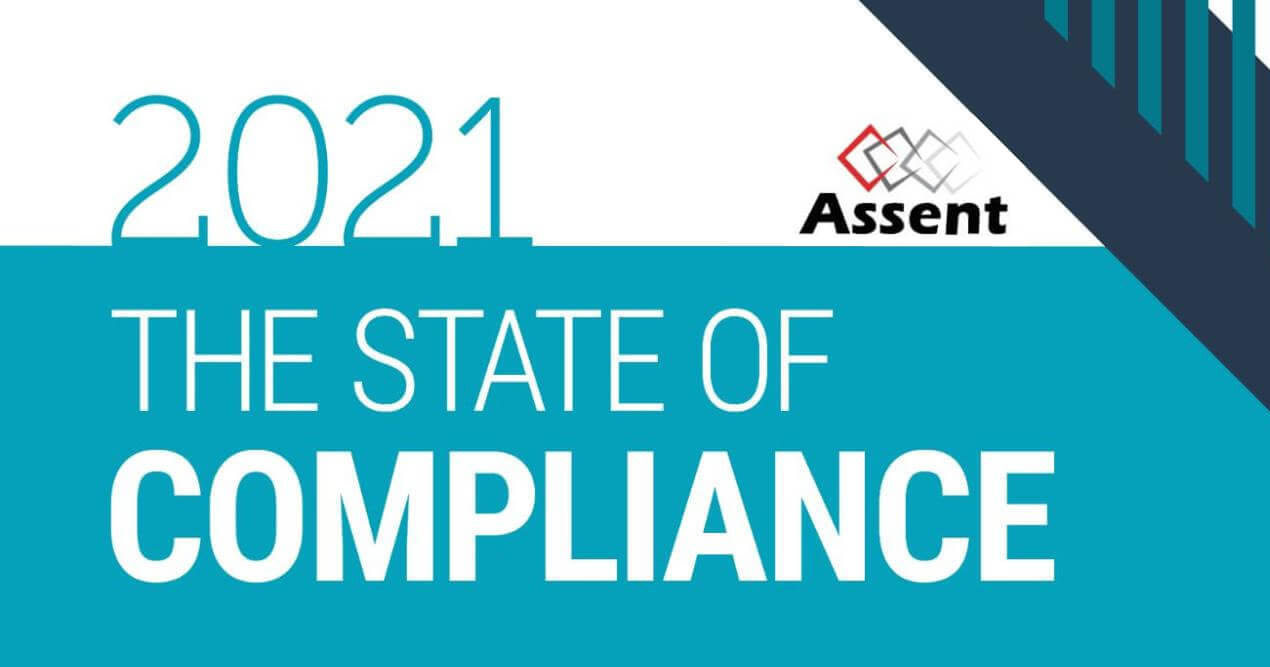The State of Compliance is Assent’s annual report on emerging trends and challenges in the product compliance space. For the 2021 report, we interviewed 712 compliance professionals to learn about their top priorities over the next year and the puzzles they’re currently facing.
By reading this report, you will learn about:
- The top three challenges your peers are currently facing.
- The next compliance trend to watch out for.
- Strategic priorities reported by your peers in the durable goods sector.
One clear takeaway? Change has been a predominant factor in the regulatory compliance sphere. Product compliance and regulatory compliance professionals had to endure a lot of change in the workplace due to COVID-19 and are now actively seeking program stability.
Takeaway 1: Top Compliance Challenges
Assent asked respondents about the challenges their companies are currently facing, and three answers stood out as top, pressing concerns. Respondents were able to select multiple answers to this question, with the top challenges being those most frequently reported across the poll group:
- Evolving regulations, including the addition of new substances, new requirements, and the internal costs of updating compliance processes.
- Increasing customer data requests as a result of regulatory changes and increased investor scrutiny.
- Slowdowns from manual processes, which are exacerbated by challenges one and two.
Overall, these responses reflect the growing concern that compliance professionals will not be able to cope with evolving regulations and the ensuing customer data demands. This is especially true of those using manual systems that are inefficient, create silos, and often return lower quality data. Companies interested in protecting themselves against non-compliance risks should view this data as a sign that there is a clear and urgent need for a new approach to managing supply chain data.
Navigating the Evolving Regulatory Landscape
Over the past five years, companies have consistently reported navigating regulatory changes on the global stage amongst their greatest challenges. Access to international markets depends on complying with a wide-range of product compliance requirements, and the data needed for demonstrating compliance is typically hidden in the supply chain.
Product regulations are constantly changing, including shifting timelines, exemptions, and regular updates to restricted substance lists. Product stewards often feel as though they’re constantly playing catch up with regulators. When regulatory changes are announced, a lot of effort is expended to review product manifests and collect parts data from suppliers. It’s a resource-intensive process that routinely comes up as a pain point in the report.
Supply Chain Data Collection Methods: Diving Deeper
We asked compliance professionals for more details about their current compliance system. Here’s what they had to say.
Just over a quarter of compliance professionals reported that their company uses a dedicated supply chain or compliance management software. Fifteen percent indicated that they use an internally-built and maintained homebrew system.
Over half of all respondents reported that they were using manual processes for their supply chain data collection. However, 25 percent of all respondents also identified manual processes as a top-three challenge for the next year. It’s evident that a significant number of companies are not seeing a return on the resources they invest in manual efforts. Specifically, manual processes take longer to capture data from suppliers, and the data quality is typically lower than when using a standardized and centralized approach. Manual processes are also often associated with the creation of data silos within an organization.
We wanted to understand which manual data collection processes and tools were being used by those without software:
Manual emails and manual text documents were reported as the most common collection methods, along with the use of industry-standard templates. Other methods, including time-intensive activities like phoning suppliers and onsite audits, accounted for the remaining responses.
Manual emails and text documents have inherent risks: both require extensive hands-on effort from staff, and lack built-in quality control over retrieved data. If data is missing, or insufficient, the entire process usually needs to be restarted. Although industry-standard templates address this quality control issue by asking for specific data types and formats, they do not necessarily make capturing data across the supply chain easier. Even with industry-standard templates, companies have to manually contact suppliers, suppliers need to return the template, and then additional work is required to transcribe supplier data into company databases.
We asked both software and manual process users to rate their satisfaction with their current system. Sixty percent of respondents were unsatisfied with their current supply chain data collection system.
Notably, although the use of industry-standard templates aligns with industry best practices, dissatisfaction rates among users are still high. These results suggest that the dissatisfaction associated with manual compliance processes are not due to inexperienced personnel or processes that don’t align with industry best practices. Instead, it likely points to a cultural shift among compliance professionals toward preferring dedicated compliance software solutions.
We also asked respondents what, if any, improvements they had planned for the next three years.
Despite a reported dissatisfaction, especially with manual systems, respondents also indicated that procuring technology and increasing the budget for compliance systems were significantly lower priorities than improving existing processes and training. This data highlights an important risk feedback loop: While professionals are concerned their system won’t be able to keep up with data demands, their corporate priorities do not often include transforming from manual to digital processes. Because compliance stewardship is often seen as a cost center rather than value generator, it is frequently overlooked as a systems investment.
Takeaway 2: What’s Next in Supply Chain Management
Investor demands and customer scrutiny on companies are increasing, particularly as they relate to environmental, social, and governance (ESG) issues. While many companies aren’t prioritizing increased compliance budgets or the implementation of supply chain software, they have begun to realize that the majority of their ESG data is hidden in their supply chain, and unlocking it to attract buyers and investors will require greater supply chain visibility. This presents a major challenge to compliance professionals who are being asked to do more with the same amount of support as before.
An enhanced focus on ESG, combined with the need to keep up with rapidly-changing regulations, has compelled many companies to start planning for a digital transformation from manual data collection to a digital process. When we asked respondents about their digital transformation plans over the next few years, the majority of them — from medium to large businesses — reported that the likelihood of them undergoing a digital transformation is expected to increase year-over-year. Compliance professionals are being asked to balance this digital transformation with limited budgets and time constraints: essentially, they need to demonstrate that supply chain software will generate revenue and reduce costs rather than be another sunk compliance cost.


Understanding Digital Transformation
So, what do these companies mean when they talk about a digital transformation?
Digital transformation is focused on shifting processes from manual, reactive activities to more proactive and automated tasks. It’s a data-driven compliance management process that approaches your supply chain as a data source, and optimizes how you collect and process that data.
Typically, a digital transformation includes:
- Removing data silos between departments. The traditional data model stores data with those that collected it, but a centralized database makes it accessible and useful across multiple departments. This is especially important for product compliance and ESG projects.
- Standardizing data collection processes. This refers both to harmonizing your different data collection formats as well as streamlining the request process so you aren’t bombarding suppliers with repetitive data requests.
- Automating repetitive processes. Compliance management requires a lot of skilled expertise, but compliance professionals spend hours chasing after suppliers for data. A digital system automates the bulk of repetitive tasks, freeing up time for team members to proactively address upcoming compliance requirements.
The State of Compliance survey showed that companies are actively exploring this type of digital transformation to proactively get ahead of the evolving regulatory landscape. Shifting to digital processes also alleviates the resource costs of manual processes. Given the data about the top challenges facing companies, it’s no surprise that compliance programs are trending towards digital. Yet there’s still a gap between understanding the need for digitization and the perceived return on investment associated with the transition.
If you’re developing a more proactive compliance approach for your workplace and want to learn more about the value of supply chain management, our guide The Value of Supply Chain Data Management will give you the information your executive team wants to know.
Takeaway 3: Supply Chain Data Has Business Impacts
For this year’s report, we also surveyed compliance professionals about their companies’ strategic priorities for the next three years.


Notably, all three of the top priorities fall into the ESG category. Investors are measuring the long-term value of companies using a number of metrics that include your impact on society (diversity and inclusion) and risk management (HR risks like human rights and workers’ rights), in addition to regulatory compliance.
Supply chain data is of central importance to all ESG programs. Outsourcing has moved much of a company’s risk into the supply chain, and investors now want as much supply chain visibility as possible. For example, human rights risks are often hidden several tiers down the supply chain, closer to resource extraction. Without a formal process in place to investigate your supply chain, it’s difficult to meaningfully address ESG priorities.
Conclusions
This year’s State of Compliance report demonstrated that change is on everyone’s minds. Product compliance professionals, having experienced massive geopolitical changes and supply chain disruptions, are proactively thinking about change management.
In general, the majority of respondents were reliant on manual processes for supply chain data collection, but unhappy with the results. They are concerned that their current systems won’t be able to keep up with the rapid rate of change driven by regulatory updates and ESG becoming more mainstream.
In the face of evolving regulations, and the growing costs of replying to customer data requests, professionals are predicting a mounting need for digitally transformed processes. Currently, however, corporate budgets and priorities are still showing a gap between understanding the value of supply chain data and the investment in new technology.
The next few years present an important opportunity for compliance professionals. Rising demand for ESG data and the pressure to keep up with global regulatory changes mean that companies will look to invest in ways to improve processes and systems. By demonstrating how supply chain data management supports corporate goals and continued growth, compliance professionals can reframe their departments as revenue-generating centers of actionable data. This transformation can result in increased corporate support and investments, leading to better processes, supply chain management software solutions, and more input on ESG decisions.
Learn more about the value locked in your supply chain and how it affects your entire company. Download The Value of Supply Chain Data Management now.
Assent would like to thank all of the respondents who participated in the 2021 State of Compliance survey, as well our partners Lorax Compliance, REACHLaw, TSG, and Arcadis.
Have questions about the 2021 State of Compliance report? Contact our experts today.









